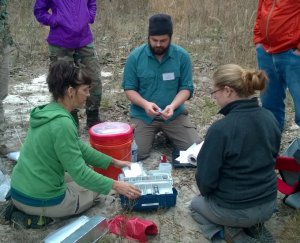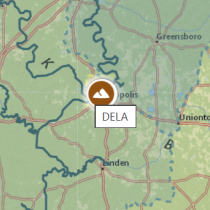A passion for rats: stepping into the role of NEON Mammal Ecologist
August 8, 2011
By Kate Thibault
I love rats. Not the big, slimy ones that live in the sewers or stow away on ships and then wreak havoc on pristine island ecosystems. I mean all of the other small mammals that inhabit the wild areas of the planet. These are the mammals that you can typically only see by throwing on an old set of field clothes, driving down a dusty dirt road, and hauling a box of heavy traps into the middle of nowhere. I recently brought my passion for rats to NEON, where I am the Mammal Ecologist, charged with the challenging task of designing the research plan for studying rats and other small mammals at NEON sites.
Please understand that small mammals are not all disease-ridden with beady red eyes (although even the disease-ridden ones do also have their charms). Some of them are among the most lovable critters around – like the silky pocket mouse pictured to the right. This species weighs in at only about 8 grams (that’s about 3 pennies), with a body length (without the tail) of less than 2 inches (50 mm), and, yes, the fur is soft and silky to the touch. Mammalogists – scientists that study mammals –typically use the term 'small mammal' to refer to an extremely large and diverse group of mammals that includes rodents (all species in the Order Rodentia, including rats, mice, and squirrels), shrews, moles, and rabbits (including pikas). See the Smithsonian's fantastic website Mammals of North America for more info about these groups and to find out which species occur in your area. Of these, rodents and some shrews are relatively easily captured in the field using simple live box traps, like the one pictured below. The combination of their often high population densities, relative ease of capture and handling, and unparalleled charisma (again, see silky pocket mouse) has led to hundreds of studies of small mammals over the last century. These studies have shown that their populations can be linked to land use and climate change. So, they can be good indicator species in ecological studies, and, unfortunately, they are also carriers of diseases important to public health. Consequently, small mammals have been selected as one of NEON’s sentinel taxa. The goal of the small mammal work at NEON is to illuminate the drivers (e.g., climate, land-use, plant productivity, insect abundance) of two aspects of rodent ecology to ultimately enable ecological forecasting. One is the demography and disease prevalence of deer mice, rodents in the genus Peromyscus that, despite their serious cuteness, are known to carry the infectious agents that cause hantavirus and Lyme disease. The other aspect of interest is the biodiversity of small mammal communities.
To help me along the way, I have access to many invaluable resources, including my own training in long-term studies in mammalogy. For a significant portion of my training, I worked with a very diverse small mammal community in southeastern Arizona (21 species!). My work was part of a long-term study of the community dynamics of small mammals, known as the Portal Project and started in 1977 by Dr. James H. Brown. Through this study, we have learned much about this community and its impacts on the surrounding plant and ant communities, including how long-term land use changes (e.g., grazing and desertification) and climate dynamics (such as those driven by the Pacific Decadal Oscillation) affect the population densities of small mammals. It is long-term studies such as this that we hope to model and build upon through the efforts of NEON. In addition to my experience at Portal, I intend to use the decades of other important research and the wealth of knowledge contained within the community of scientists at large, along with my passion for rats, to help me to build an excellent mammal program for NEON.

